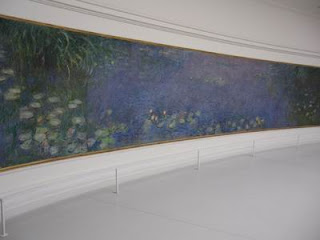The image shown
above is one of the eight Claude Monet Water Lily images on display at the Musée
de l’Orangerie in Paris. Built
solely to house eight of Monet’s water lilies, the Musée de l’Orangerie has
eight of the water lilies on display, all of which depict a pond with water
lilies in the different seasons (two per season; the above image shows the
water lilies in the Spring). Click
here for a virtual tour of the Musée de l’Orangerie (click "Visite Virtuelle" to start the tour).
In the later
years of his life, renowned impressionist artist Claude Monet created hundreds
of paintings featuring water lilies from his garden in Giverny. The above image presents water lilies during
springtime, and it is fascinating how springtime dictated many of the painting’s
elements. Spring is a transition
season from cold to warm, and these changes are expressed metaphorically by the
painting’s changing hues, from darker blues to lighter lavenders. It appears as if rays of light are
pouring onto the pinker sections of the water, a deliberate choice that uses
pathos to appeal to the audience’s typical associations with springtime as a
time of light and growth. The
painting appeals to natural human emotional connections between light colors
and feelings of peace and tranquility, which likely resonates with a wide audience of people around the
world. In particular, the painting’s
positive depiction of the pond seems like an endeavor to impress upon the
audience the value of natural beauty. Monet effectively uses his audience’s cultural memory, which
helps lead the audience to the painting’s purpose. Monet’s purpose was to have his water lilies cohesively act
as a motif of water, and remarked, “The motif's essential is the mirror of water whose aspect is constantly
being modified.” This is immediately clear to the
viewer: the focal point of water, with the water lilies and tree simply as the
painting’s border, highlights water’s importance to the image as well as its
diversity, and the pastel colors used create feelings associated with
springtime.

No comments:
Post a Comment